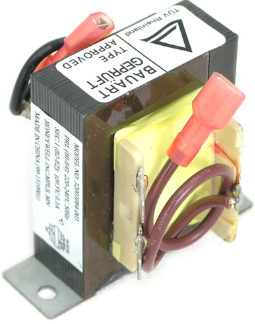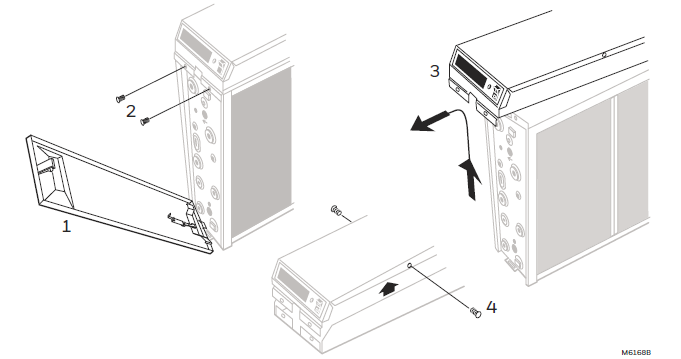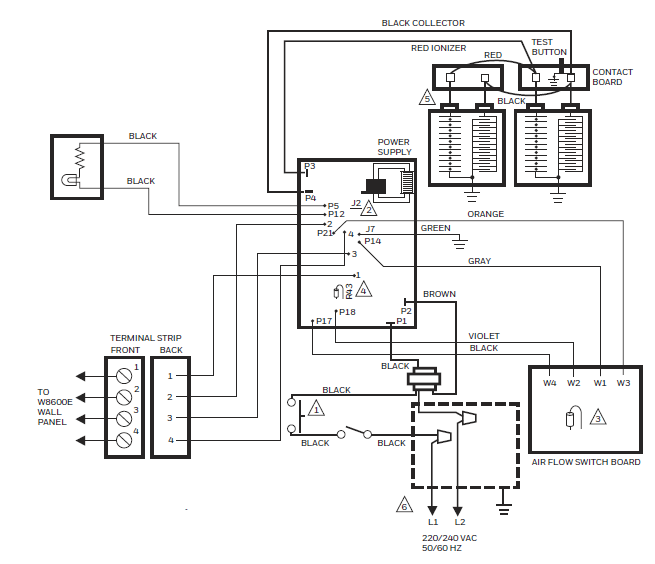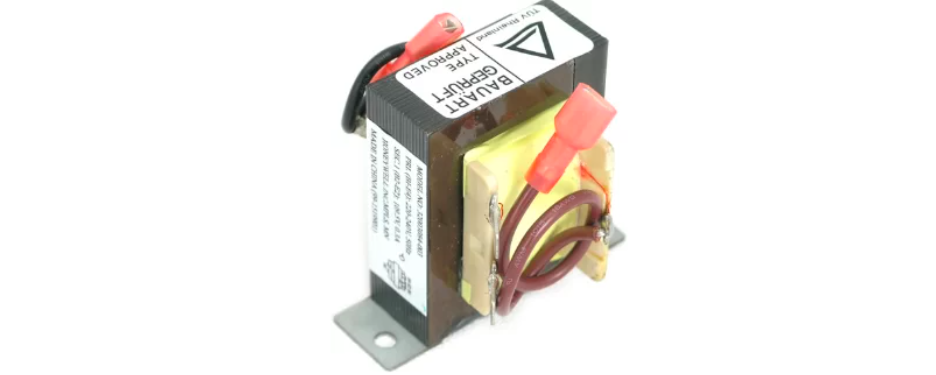Honey Well 203365A Electronic Air Cleaners Manual

APPLICATION
The 203365A Conversion Kit changes the 120 Vac, 60 Hz to 220/240 Vac, 50/60 Hz. The kit includes a transformer and two screws. The line cord on the air cleaner must be changed to conduit to complete the conversion.
NOTE: The air cleaner can be completely isolated from the electrical circuit of the HVAC system unless required by local code to use same circuit. Any convenient house circuit can power the air cleaner, regardless of electrical
rating of HVAC system.
INSTALLATION
WHEN INSTALLING THIS PRODUCT
- Read these instructions carefully. Failure to follow them could damage the product or cause a hazardous condition.
- Check the ratings given in the instructions and on the product to make sure the product is suitable for your application.
- Installer must be a trained, experienced service technician.
- After installation is complete, check out product operation as provided in these instructions.
MOUNT TRANSFORMER
- Open access door.
- Remove and retain the two screws from the front of the power box.
- Lift and remove the power box.
- Remove and retain the two screws from the sides of the power box. See Fig. 1.
- Remove the power box cover.
- Place the transformer on the mounting holes. See Fig. 2.

- NOTE: Be sure the transformer terminals are located on the side away from the power supply. See Fig. 2.
- Use the two provided screws to secure the transformer to the power box.
WIRE TRANSFORMER TO POWER SUPPLY
- Remove black wire from power supply P1 terminal and place it on one of the transformer terminals.
- Connect the transformer black lead to the power supply P1 terminal.
- Remove brown wire from power supply P2 terminal and place it on the empty transformer terminal.
- Connect the transformer brown lead to the power supply P2 terminal.See Fig. 3 for internal schematic for the electronic air cleaner with conversion kit.

CHANGE PLUG TO CONDUIT
CAUTION
ELECTRIC SHOCK HAZARD.CAN CAUSE ELECTRICAL SHOCK OR EQUIPMENT DAMAGE.
Disconnect power before installing replacement power supply board.
- In the power box, remove and retain two wire nuts that connect the line cord leads to the power box wiring.
- Remove the power green lead from the green grounding screw on the wiring compartment barrier.
- Remove the power cord and the strain relief.
- Put the provided plug in the hole left by the power cord.
COMPLETE WIRING
CAUTION
ELECTRIC SHOCK HAZARD.CAN CAUSE ELECTRICAL SHOCK OR EQUIPMENT DAMAGE.
Disconnect power before wiring.
- Attach conduit through a power box side knockout.
- Wire the air cleaner directly to the line voltage using wire nuts. See Fig. 3. Secure ground connection to the green ground screw on the wiring compartment barrier.
- Replace power supply box, cover and access door.

- INTERLOCK SWITCH.
- OUTPUT REDUCTION JUMPER.
- AIRFLOW SWITCH DISABLE JUMPER.
- RESISTOR FOR W8600 WASH INDICATION THRESHOLD.
- ONE-CELL UNIT SIMILAR, BUT WITH JUST ONE CELL.
- POWER SUPPLY. PROVIDE DISCONNECT MEANS AND OVERLOAD PROTECTION AS REQUIRED.
CHECKOUT
WARNING
ELECTRIC SHOCK HAZARD.CAN CAUSE PERSONAL INJURY OR EQUIPMENT DAMAGE.
The following procedures expose hazardous live parts. Disconnect from power supply between checks and proceed carefully. These instructions are for use by only qualified personnel.With all components in place, connect power to the air cleaner. Turn on the air cleaner switch to energize the system blower. Check the following points of
operation:
- The neon light next to the on-off switch is on. If a W8600E is part of the installation, check the wall
panel and make sure the ON LED is lit. The W8600E CHECK LED will come on if there is a problem with the high voltage power supply. - Turn off the system blower. The neon light should go off after a few seconds. The neon light indicates that the air cleaner is energized and the high voltage power supply is working properly.
- Turn on the system blower. With the air cleaner energized, push the test button. A snapping sound indicates that the collector voltage is present on the cell. The W8600E CHECK LED will come on when the test button is held down.
- With a multi speed blower, repeat steps 1 through 3 for each fan speed.
- If operation is not as described, refer to the Electrical Troubleshooting section.
Electrical Troubleshooting
WARNING
ELECTRIC SHOCK HAZARD.CAN CAUSE PERSONAL INJURY OR EQUIPMENT DAMAGE.
The following procedures expose hazardous live parts. Disconnect from power supply between checks and proceed carefully. These instructions are for use by only qualified personnel.
TOOLS AND EQUIPMENT
Troubleshooting the electronic air cleaner requires:
- Needle nose pliers for stringing ionizer wires and inserting edge connectors.
- Test meter.
NEON LIGHT (ON POWER BOX)
The neon light is powered through the power supply and is on when the power supply output voltage is normal.
TEST BUTTON
When pushed, the test button shorts from collector voltage to ground. The resulting arcing sound indicates that high voltage is being supplied to the collector. The solid state power supply controls current flow to the collector. On air cleaners with a W8600E,the CHECK LED will come on when the test button is held down.
CHECK LED (AIR CLEANERS WITH W8600E)
The CHECK LED is on the W8600E. It lights to indicate the following problems: excessive dirt loading (beyond
that required to activate the WASH LED), partial shorting of the collector, continuous ionizer or collector arcing, power supply failure, excessive ionizer current, or any condition causing a major reduction in high voltage.
POWER BOX
WARNING
ELECTRIC SHOCK HAZARD.CAN CAUSE PERSONAL INJURY.
Always turn off power and remove access door before removing power supply or its cover.The solid-state power supply within the power supply box can be replaced. When troubleshooting indicates a power supply or solid-state performance indicator problem, replace the entire power box or replace the power supply within the box. See Installation Instructions, form 69-0776. See Fig. 1 for power box removal.
TROUBLESHOOTING PROCEDURE
The electronic air cleaner troubleshooting chart shows how to quickly isolate a problem in the air cleaner. See
Fig. 4. Although a meter is needed for some steps, the primary diagnostic tools are the neon light and the test
button.






 Afrikaans
Afrikaans Albanian
Albanian Amharic
Amharic Arabic
Arabic Armenian
Armenian Azerbaijani
Azerbaijani Basque
Basque Belarusian
Belarusian Bengali
Bengali Bosnian
Bosnian Bulgarian
Bulgarian Catalan
Catalan Cebuano
Cebuano Chichewa
Chichewa Chinese (Simplified)
Chinese (Simplified) Chinese (Traditional)
Chinese (Traditional) Corsican
Corsican Croatian
Croatian Czech
Czech Danish
Danish Dutch
Dutch English
English Esperanto
Esperanto Estonian
Estonian Filipino
Filipino Finnish
Finnish French
French Frisian
Frisian Galician
Galician Georgian
Georgian German
German Greek
Greek Gujarati
Gujarati Haitian Creole
Haitian Creole Hausa
Hausa Hawaiian
Hawaiian Hebrew
Hebrew Hindi
Hindi Hmong
Hmong Hungarian
Hungarian Icelandic
Icelandic Igbo
Igbo Indonesian
Indonesian Irish
Irish Italian
Italian Japanese
Japanese Javanese
Javanese Kannada
Kannada Kazakh
Kazakh Khmer
Khmer Korean
Korean Kurdish (Kurmanji)
Kurdish (Kurmanji) Kyrgyz
Kyrgyz Lao
Lao Latin
Latin Latvian
Latvian Lithuanian
Lithuanian Luxembourgish
Luxembourgish Macedonian
Macedonian Malagasy
Malagasy Malay
Malay Malayalam
Malayalam Maltese
Maltese Maori
Maori Marathi
Marathi Mongolian
Mongolian Myanmar (Burmese)
Myanmar (Burmese) Nepali
Nepali Norwegian
Norwegian Pashto
Pashto Persian
Persian Polish
Polish Portuguese
Portuguese Punjabi
Punjabi Romanian
Romanian Russian
Russian Samoan
Samoan Scottish Gaelic
Scottish Gaelic Serbian
Serbian Sesotho
Sesotho Shona
Shona Sindhi
Sindhi Sinhala
Sinhala Slovak
Slovak Slovenian
Slovenian Somali
Somali Spanish
Spanish Sundanese
Sundanese Swahili
Swahili Swedish
Swedish Tajik
Tajik Tamil
Tamil Telugu
Telugu Thai
Thai Turkish
Turkish Ukrainian
Ukrainian Urdu
Urdu Uzbek
Uzbek Vietnamese
Vietnamese Welsh
Welsh Xhosa
Xhosa Yiddish
Yiddish Yoruba
Yoruba Zulu
Zulu